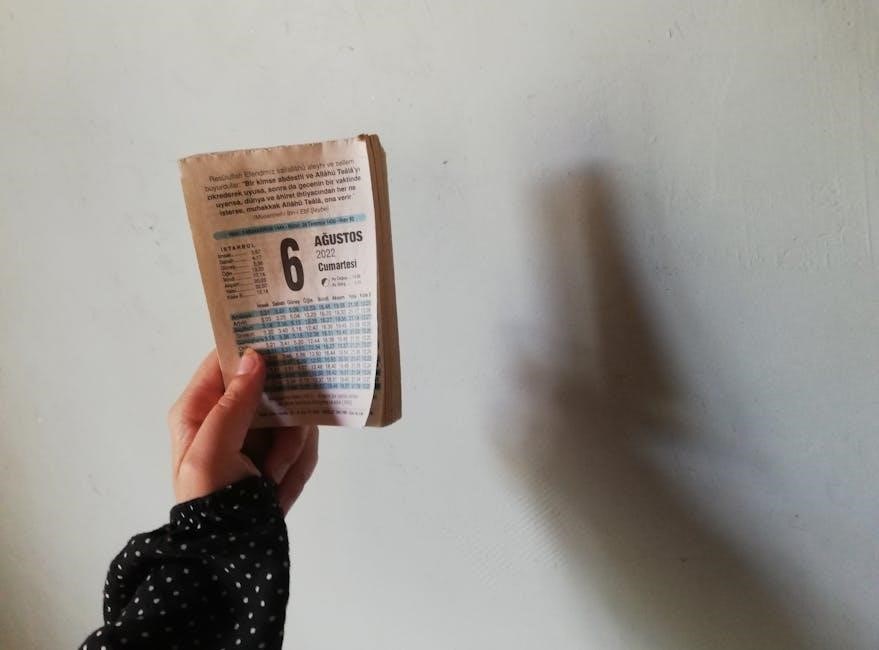The Absolutely True Diary of a Part-Time Indian is a semi-autobiographical novel by Sherman Alexie, blending humor and heartbreak to explore reservation life and identity.
1.1 Overview of the Book
The Absolutely True Diary of a Part-Time Indian, written by Sherman Alexie, is a young adult novel that recounts the life of Arnold Spirit Jr., a teenager navigating the challenges of growing up on a Native American reservation. The story is presented in a diary format, offering an intimate and raw perspective of Junior’s experiences. It explores themes of identity, belonging, and hope as Junior transitions from his reservation school to a predominantly white high school. The novel is notable for its blend of humor, gritty realism, and poignant reflections on race, culture, and family. Junior’s journey is complemented by his passion for cartooning, which serves as a creative outlet and a way to process his emotions; The book has received widespread acclaim for its honest portrayal of adolescence and resilience, earning the National Book Award for Young People’s Literature in 2007.
1.2 Author Background: Sherman Alexie
Sherman Alexie, born in 1966 on the Spokane Indian Reservation, is a celebrated American writer, poet, and filmmaker. His work often explores the complexities of Native American life, blending humor with poignant portrayals of reservation experiences. Drawing heavily from his own life, Alexie’s writing reflects his journey from a challenging upbringing to becoming a prominent literary figure. His semi-autobiographical novel, The Absolutely True Diary of a Part-Time Indian, mirrors his decision to leave his reservation school for a better education, highlighting themes of identity and resilience. Alexie’s contributions to literature have earned him numerous accolades, including the National Book Award for Young People’s Literature in 2007. His influence extends beyond literature, addressing cultural and social issues that resonate broadly.

Major Themes in the Book
Hope, dreams, and loss intertwine with identity and belonging as Junior navigates reservation life and the outside world, revealing resilience amid cultural and personal challenges.
2.1 Hope, Dreams, and Loss
Hope, dreams, and loss are central to Junior’s journey. His aspiration to escape poverty and find a better life drives his decisions, even as he faces the harsh realities of reservation life. The novel vividly portrays his struggles with identity, family hardships, and personal tragedies, such as the death of loved ones. Despite these losses, Junior’s resilience and determination to succeed highlight the enduring power of hope. His experiences reflect the broader challenges faced by Native American communities, blending poignant moments of grief with moments of triumph and growth. Through his diary, Junior expresses both the pain of loss and the strength of his dreams, creating a narrative that resonates deeply with readers.
2.2 Identity and Belonging
Identity and belonging are central themes in The Absolutely True Diary of a Part-Time Indian. Junior, a Native American teenager, struggles to find his place between the reservation and the white-dominated world. His decision to attend a predominantly white high school amplifies his feelings of alienation, as he becomes an outsider in both environments. The novel explores the tension between cultural heritage and the desire to assimilate, highlighting Junior’s internal conflict. His experiences reflect the broader challenges of identity faced by marginalized communities, particularly Native Americans, in navigating dual worlds. Through humor and poignant storytelling, Alexie sheds light on the complexities of belonging and the resilience required to forge a sense of self amidst conflicting cultural expectations.
Plot Summary
The Absolutely True Diary of a Part-Time Indian follows Junior, a Native American teenager, as he leaves his reservation to attend a white-dominated high school. His journey explores identity, hope, and loss, blending humor with poignant reflections on reservation life and cultural divides.
3.1 Setting: Reservation Life and Beyond
The Absolutely True Diary of a Part-Time Indian is set primarily on the Spokane Indian Reservation and in the predominantly white town of Reardan. The reservation, marked by poverty and limited opportunities, contrasts sharply with the more affluent and resources-rich Reardan, where Junior begins attending high school. This dual setting highlights the stark differences between reservation life and the outside world, emphasizing themes of cultural identity, social inequality, and the challenges of bridging these two disparate worlds. The setting plays a crucial role in shaping Junior’s experiences, offering a backdrop for his struggles and growth as he navigates both environments. The vivid portrayal of these settings underscores the broader realities faced by Native American communities.
3.2 Main Characters and Their Roles
Junior Spirit, the protagonist, is a bright, aspiring cartoonist navigating life on the Spokane Reservation and his predominantly white high school. His family, including his abusive but loving brother Rowdy, his hardworking father, and his compassionate mother, play pivotal roles in his life. Mr. P, a supportive teacher, encourages Junior to pursue his education off the reservation, while Ms. Warren, his Reardan teacher, helps him embrace his intellect. Penelope, a popular student, and Ted, his friend, represent the complexities of relationships in his new environment. Each character contributes to Junior’s journey of self-discovery, identity, and resilience, highlighting the challenges and triumphs of his dual-world existence.

Symbolism in the Novel
Basketball and cartoons serve as powerful symbols, representing hope, escape, and self-expression. Basketball embodies Junior’s dreams and resilience, while his cartoons illustrate his inner world and creativity. Together, they highlight his journey toward identity and understanding, reflecting the broader themes of the novel. His art becomes a bridge between his two worlds, offering a unique perspective on his experiences and emotions, and serving as a means of coping with the challenges he faces. These symbols are central to the narrative, enriching the storytelling and providing deeper insight into Junior’s character development and growth. They are integral to the novel’s exploration of hope, loss, and the struggle for identity, making them a cornerstone of the story’s emotional and thematic depth. By weaving these symbols throughout the text, Alexie creates a layered and meaningful narrative that resonates with readers on multiple levels, ensuring that the story remains impactful and memorable long after the final page is turned. Additionally, the use of these symbols allows for a nuanced exploration of Junior’s internal conflicts, as he navigates the complexities of his dual identity and the harsh realities of his environment. Through these elements, Alexie crafts a story that is both deeply personal and universally relatable, offering readers a profound understanding of the human experience. Ultimately, the symbolism in the novel underscores the importance of perseverance, creativity, and the pursuit of one’s aspirations, even in the face of adversity. By doing so, it leaves a lasting impression on the reader, inviting reflection on the ways in which symbols shape our understanding of the world and ourselves.
4.1 The Significance of Basketball
Basketball is a central symbol in the novel, representing hope, resilience, and Junior’s escape from the hardships of reservation life. It serves as a bridge between his two worlds, offering camaraderie and acceptance. Through basketball, Junior finds his identity and voice, using the sport as a means to connect with his peers and transcend the limitations of his environment. The court becomes a space where he can temporarily forget his struggles, channeling his emotions into determination and focus. Basketball also symbolizes Junior’s aspirations and the broader theme of rising above adversity. It is through this sport that he learns to navigate his dual identity, finding strength in both his heritage and his new life. Ultimately, basketball embodies Junior’s journey of self-discovery and his unwavering hope for a better future.
4.2 The Role of Cartoons and Art
Cartoons and art play a vital role in Junior’s storytelling, serving as both an emotional outlet and a narrative device. Junior, an aspiring cartoonist, uses his drawings to express feelings he struggles to articulate verbally. His art becomes a bridge between his inner world and the external realities of reservation life. The cartoons are woven into the text, often providing visual commentary on key events or themes; They reflect Junior’s humor, creativity, and ability to find light in darkness. Through his art, Junior preserves his cultural heritage while exploring his identity. The integration of cartoons adds a unique layer to the diary format, making the story more intimate and visually engaging. Ultimately, Junior’s art symbolizes his resilience and his determination to carve out his own path in life.

Cultural Aspects
The novel vividly portrays Native American culture, traditions, and the struggles of reservation life, highlighting the tension between preserving heritage and navigating the outside world’s expectations and influences.
5.1 Native American Culture and Traditions
The novel delves into the rich tapestry of Native American culture, showcasing traditions such as storytelling, ceremonies, and the importance of family and elders. Sherman Alexie highlights the resilience of these customs despite historical oppression and modern challenges, offering a poignant yet hopeful portrayal of cultural preservation. The protagonist, Junior, often reflects on the spiritual and communal aspects of his heritage, which serve as a source of strength and identity amidst adversity. Through these elements, Alexie not only educates readers about Native American traditions but also underscores their enduring relevance in contemporary life.
5.2 The Reservation vs. the Outside World
The novel vividly contrasts life on the reservation with the outside world, highlighting stark differences in opportunities, resources, and societal expectations. Junior’s journey from the reservation to a predominantly white high school underscores the cultural and economic divide. The reservation is portrayed as a place of deep-rooted tradition and community but also of poverty and limited possibilities. In contrast, the outside world offers access to education and potential but comes with challenges of racism, alienation, and identity crises. This duality serves as a backdrop for Junior’s struggle to bridge two worlds, ultimately finding a balance between preserving his heritage and embracing new experiences.

Writing Style and Structure
The novel’s writing style blends humor with pathos, using a conversational tone to explore themes of identity. Alexie employs irony and a authentic teenage voice to convey Junior’s resilience.
6.1 Diary Format and Its Impact
The Absolutely True Diary of a Part-Time Indian is written in a diary format, which creates an intimate and personal narrative voice. This structure allows readers to witness Junior’s raw emotions, struggles, and growth firsthand, fostering a deep connection with his journey. The diary entries are concise and often fragmented, mirroring the chaos and unpredictability of Junior’s life. This format also enables Alexie to blend humor with vulnerability, making the protagonist’s experiences feel authentic and relatable. The use of the diary conceit provides a unique lens through which themes of identity, hope, and loss are explored, offering readers a candid glimpse into the mind of a young Native American navigating two worlds. This approach enhances the novel’s emotional impact and accessibility.
6.2 Humor and Irony in the Narrative
Humor and irony are central to the narrative of The Absolutely True Diary of a Part-Time Indian, serving as both a coping mechanism for Junior and a way to highlight the absurdities of his life. Alexie uses wit to address painful topics such as poverty, racism, and loss, making the story more accessible while underscoring its emotional depth. Junior’s sarcastic remarks and ironic observations provide comic relief, yet they also reveal his resilience and sharp intellect; The interplay between humor and pathos creates a balanced tone, allowing readers to connect with Junior’s struggles without becoming overwhelmed. This blend of humor and irony not only reflects Alexie’s storytelling style but also enriches the narrative, making it both poignant and engaging. The result is a story that is as funny as it is heartrending.
Reception and Reviews
The Absolutely True Diary of a Part-Time Indian received widespread acclaim for its raw storytelling, earning a National Book Award and praise for its authentic, poignant narrative.
7.1 Critical Acclaim and Awards
The Absolutely True Diary of a Part-Time Indian garnered significant critical acclaim, winning the 2007 National Book Award for Young People’s Literature. It was praised for its authentic portrayal of reservation life, blending humor with poignant themes of identity and resilience. The novel also received the American Indian Library Association’s Youth Literature Award and was named one of the best books of 2007 by Publishers Weekly and School Library Journal. These accolades highlight Sherman Alexie’s ability to craft a story that resonates deeply with readers, offering both a personal and universal narrative about growing up and finding one’s place in the world.
7.2 Audience Response and Popularity
The Absolutely True Diary of a Part-Time Indian has resonated deeply with readers, particularly young adults, for its raw authenticity and relatable themes. The novel’s autobiographical elements, drawn from Sherman Alexie’s own experiences, have made it a favorite among readers seeking stories about identity, culture, and resilience. Its diary format and humorous tone have made it accessible to a wide audience, fostering a connection with readers from diverse backgrounds. The book’s popularity is further evident in its inclusion in school curricula and its status as a modern classic in young adult literature, sparking important discussions about race, class, and belonging. Its enduring appeal lies in its ability to balance heartbreak with hope, making it a cherished read for many.
Controversies and Challenges
The Absolutely True Diary of a Part-Time Indian faced bans in multiple districts due to language and content, sparking debates on censorship and freedom of expression, with support from advocacy groups.
8.1 Censorship and Book Bans
The Absolutely True Diary of a Part-Time Indian has faced significant censorship and book bans in various school districts; Many have objected to its explicit language, sexual references, and portrayal of sensitive topics such as poverty and alcoholism. For instance, the novel was banned in Richland, Washington, and West Ada School District, Idaho, due to parental complaints. Despite its literary acclaim, the book has been challenged for its content, with some arguing it is inappropriate for young readers. However, supporters emphasize its value in addressing real-world issues and fostering empathy. The American Library Association has consistently defended the novel, highlighting its importance in promoting diverse voices and intellectual freedom. This ongoing debate underscores the tension between censorship and the need for authentic, thought-provoking literature in education. Sherman Alexie’s work remains a focal point in discussions about book bans and their impact on students and society.
8.2 Debates Over Content and Appropriateness
The Absolutely True Diary of a Part-Time Indian has sparked debates over its content and suitability for young readers. Critics argue that Sherman Alexie’s frank portrayal of sexuality, profanity, and alcoholism is inappropriate for adolescents. Others defend the novel, asserting that it tackles real issues faced by Native American youth with raw honesty and humor. The book’s exploration of identity, poverty, and cultural struggles resonates deeply, making it a valuable educational tool. However, some educators and parents believe certain themes and language may not align with school standards, leading to restrictions. The debate highlights the tension between preserving authenticity and ensuring age-appropriateness, reflecting broader discussions about literature’s role in addressing difficult truths. This ongoing conversation underscores the novel’s impact and relevance in contemporary education.

Educational Significance
The Absolutely True Diary of a Part-Time Indian is widely used in schools for its authentic portrayal of identity, culture, and resilience, fostering empathy and critical thinking among students.
9.1 Use in School Curricula
The Absolutely True Diary of a Part-Time Indian is widely adopted in school curricula for its authentic portrayal of identity, culture, and resilience. Educators value its ability to spark discussions on racism, poverty, and the Native American experience. The novel is often included in young adult literature courses due to its relatable themes and accessible narrative style. Many schools have incorporated it to address diverse voices and promote empathy. Despite controversies, its educational significance remains undeniable, offering students a unique perspective on marginalized communities. Its inclusion in curricula reflects a growing emphasis on representing underheard stories and fostering critical thinking about social issues.
9.2 Teaching Themes and Issues
The Absolutely True Diary of a Part-Time Indian offers a rich framework for teaching themes such as hope, identity, and loss. Educators often focus on Junior’s journey, exploring how he navigates cultural divides and personal tragedy. The novel’s gritty realism provides opportunities to discuss poverty, alcoholism, and the historical impact of colonialism on Native communities. Teachers also highlight the importance of resilience and the power of art, as Junior uses cartoons to express his emotions. These themes encourage students to reflect on their own identities and challenges, fostering empathy and self-awareness. The book’s diary format makes it accessible, allowing educators to integrate creative writing and visual art projects into their lessons, enriching the learning experience;
Historical Context
The Absolutely True Diary of a Part-Time Indian reflects Sherman Alexie’s experiences growing up on a reservation, highlighting the historical struggles of Native Americans, including colonialism’s lasting impact.
10.1 Historical Background of Native Americans
The novel reflects the broader historical struggles of Native Americans, including forced relocation, cultural suppression, and poverty. These experiences shape Junior’s identity and his community’s resilience. The reservation system, established by colonial powers, created isolated communities with limited resources, perpetuating cycles of hardship. Sherman Alexie draws from his own upbringing to depict these challenges, offering a raw yet hopeful portrayal of life on the reservation. The legacy of colonialism and its enduring effects are central themes, providing context for Junior’s journey and the struggles faced by his family and community. This background underscores the novel’s exploration of identity, loss, and hope.
10.2 The Impact of Colonialism
Colonialism profoundly shaped the lives of Native Americans, leading to displacement, cultural erasure, and economic hardship. The novel highlights how historical trauma impacts Junior’s family and community. The reservation system, a legacy of colonial policies, perpetuates poverty and isolation. Sherman Alexie’s portrayal of reservation life reflects the lingering effects of colonialism, including limited access to education and healthcare. These systemic inequalities contribute to cycles of despair and resilience, as seen in Junior’s struggles and aspirations. The novel underscores how colonialism’s aftermath influences identity, culture, and hope, offering a powerful critique of historical injustices and their ongoing impact on Native American communities.

Psychological Insights
The novel explores Junior’s mental and emotional journey, delving into themes of resilience, identity, and the intergenerational trauma affecting his family and community.
11.1 Junior’s Mental and Emotional Journey
Junior’s journey in The Absolutely True Diary of a Part-Time Indian is marked by his struggle with identity, poverty, and belonging. Growing up on a reservation, Junior faces numerous challenges, including the death of loved ones and feelings of alienation. His decision to leave the reservation to attend a predominantly white school intensifies his internal conflict, as he grapples with cultural dislocation and self-doubt. Through his diary entries, Junior expresses his pain, hope, and resilience, illustrating the emotional toll of navigating two vastly different worlds. His experiences reflect the broader psychological impact of historical trauma and marginalization on Native American youth, while also highlighting his determination to find his place and forge a better future.
11.2 Family Dynamics and Relationships
In The Absolutely True Diary of a Part-Time Indian, Junior’s family plays a central role in shaping his identity and emotional growth. His parents, though struggling with poverty and alcoholism, provide unwavering support, encouraging Junior to pursue his education and dreams. His father, in particular, embodies resilience and quiet strength, while his mother offers compassion and understanding. Junior’s relationship with his best friend, Rowdy, is deeply complex, blending loyalty and tension as they navigate their shared experiences on the reservation. These dynamics highlight the challenges of family life on the reservation while also showcasing the enduring love and solidarity that sustain Junior throughout his journey. The novel portrays family as both a source of pain and a foundation of strength.
Legacy and Impact
The Absolutely True Diary of a Part-Time Indian has left a lasting impact on young adult literature, addressing cultural and social issues with authenticity and humor, earning critical acclaim and widespread recognition for its thought-provoking narrative and educational significance.
12.1 Influence on Young Adult Literature
The Absolutely True Diary of a Part-Time Indian has been groundbreaking in young adult literature, offering a raw, unfiltered voice that resonates deeply with readers. Sherman Alexie’s semi-autobiographical narrative has redefined how stories about identity, culture, and resilience are told. The book’s blend of humor, heartache, and honesty has inspired a new wave of authors to explore diverse perspectives. Its impact is evident in its numerous awards, including the National Book Award, and its inclusion in school curricula despite censorship challenges. By addressing themes like poverty, race, and belonging, Alexie’s work has expanded the scope of YA literature, making it more inclusive and thought-provoking. The novel’s legacy lies in its ability to spark conversations about marginalized voices and the power of storytelling.
12.2 Cultural and Social Significance
The Absolutely True Diary of a Part-Time Indian holds profound cultural and social significance, offering a candid portrayal of Native American life and identity. Sherman Alexie’s narrative challenges stereotypes, providing a voice to marginalized communities and fostering empathy. The book’s exploration of reservation life, poverty, and cultural identity resonates widely, sparking conversations about systemic inequalities. Its raw authenticity has made it a vital tool for education, encouraging discussions on race, class, and belonging. Despite censorship attempts, the novel’s impact endures, celebrating resilience and the power of storytelling. By blending humor with heartache, Alexie bridges cultural divides, making the experiences of Native Americans accessible and relatable to a broader audience, while preserving the richness of their heritage.
